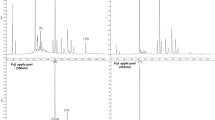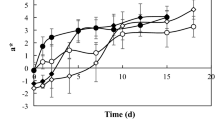Abstract
Consumption of fresh apple fruits can induce allergic reactions in humans. The apple allergen Mal d 1 is responsible for these allergic reactions in humans in Central Europe and North America. Biosynthesis of Mal d 1 depends on apple cultivar, and its concentration increases with time during fruit storage. However, data on the impact of different fruit storage conditions during long-term storage are scarce. Hence, the Mal d 1 contents of eight apple cultivars were analyzed for this study during long-term storage in a cold chamber as well as under controlled atmosphere conditions (CA).
After harvest, apple fruits were stored for 12, 20, 28 or 36 weeks in a cold-chamber at + 2 °C or as under controlled atmosphere conditions of 1.5 % CO2, 1.5 % O2 at + 2 °C. Mal d 1 content in apple fruit of all eight cultivars examined increased during fruit storage. In most cases, differences between Mal d 1 of apple fruits stored in the cold chamber and under CA conditions were significant, but inconsistent. In apple cv. ‘Elise’, fruits stored in the cold chamber contained more Mal d 1 compared with those stored in CA, whereas the situation reversed in other varieties like cv. ‘Boskoop’. The greatest Mal d 1 content was measured in fruits of cvs. ‘Golden Delicious’ and ‘Gala’, whereas the smallest Mal d 1 level was in cvs. ‘Elise’ and ‘Pinova’ over the whole storage time. Overall, this experiment showed the complexity of the relationship between the Mal d 1 content, allergenicity of apple fruits, different cultivars, storage conditions and storage time. Persons allergic to apple fruits should consume the fruits as fresh as possible or only after a limited storage time. Furthermore, they should prefer apple varieties with a low content of allergenic proteins, such as cv. ‘Elise’ or cv. ‘Boskoop’ as a cultivar known for its large polyphenol content.
Zusammenfassung
Der Konsum frischer Äpfel kann zu allergischen Reaktionen führen. Verantwortlich für diese Reaktionen ist bei Menschen in Zentraleuropa sowie in Nordamerika das Apfelallergen Mal d 1. Die Synthese von Mal d 1 ist sortenabhängig und die Konzentration dieses allergenen Proteins steigt während der Lagerung an. Es gibt jedoch nur wenige Informationen über den Einfluss verschiedener Lagerbedingungen während der Langzeitlagerung auf den Mal d 1-Gehalt. Daher wurde für diese Studie der Mal d 1 Gehalt acht unterschiedlicher Apfelsorten während der Kühllagerung bei + 2 °C sowie unter kontrollierter Atmosphäre analysiert.
Nach der Ernte wurden die Früchte für 12, 20, 28 und 36 Wochen im Kühllager bei + 2 °C sowie unter kontrollierter Atmosphäre (1.5 % CO2, 1.5 % O2) bei + 2 °C gelagert. Bei allen Apfelsorten stieg der Mal d 1 Gehalt während der Lagerung an. Zudem unterschieden sich in den meisten Fällen die Mal d 1 Gehalte in Abhängigkeit von der Lagerart. Jedoch waren die Ergebnisse nicht einheitlich. Für die Apfelsorte ‘Elise’ wurden höhere Mal d 1 Gehalte bei kühlgelagerten Früchten im Vergleich zu CA-gelagerten Früchten ermittelt. Das Ergebnis für Früchte der Sorte ‘Boskoop’ hingegen war genau umgekehrt. Der höchste Mal d 1 Gehalt wurde in Früchten der Sorten ‘Golden Delicious’ und ‘Gala’ ermittelt, während der geringste Mal d 1 Gehalt über den gesamten Lagerzeitraum für die Sorten ‘Pinova’ und ‘Elise’ gemessen wurde. Diese vorliegende Studie verdeutlicht die Komplexität der Zusammenhänge von Mal d 1-Gehalt, allergenem Potential der Früchte, unterschiedlicher Sorten, Lagerungsbedingungen sowie der Lagerdauer. Apfelallergiker sollten die Früchte so frisch wie möglich konsumieren oder nur nach einer kurzen Lagerperiode. Zudem sollten sie Apfelsorten bevorzugen, die einen geringen Allergengehalt haben, wie beispielsweise die Sorte ‘Elise’ oder ‘Boskoop’ und/oder solche mit hohem Polyphenolgehalt sowie hoher PPO (Polyphenoloxidase)-Aktivität.

Similar content being viewed by others
References
Amlot PL, Kemeny DM, Zachary C, Parkes P, Lessof MH (1987) Oral allergy syndrome (OAS): symptoms of IgE-mediated hypersensitivity to foods. Clin Allergy 17:33–42
Asero R, Marzban G, Martinelli A, Zaccarini M, Laimer da Câmara Machado M (2006) Search for low allergenic apple cultivars for birch pollen-allergic patients: is there a correlation between in vitro assays and patient response? Eur Ann Allergy Clin Immunol 38(3):94–98
Atkinson RG, Perry J, Matsui T, Ross GS, Macrae EA (1996) A stress-, pathogenesis-, and allergen-related cDNA in apple fruit is also ripening-related. N Z J Crop Hortic Sci 24:103–107
Barett DM, Lee CY, Liu FW (1991) Changes in ‘delicious’ apple browning and softening during controlled atmosphere storage. J Food Qual 14:443–453
Björksten F, Halmepuro L, Hannuksela M, Lahti A (1980) Extraction and properties of apple allergens. Allergy 35:671–677
Bolhaar STHP, van de Weg WE, van Ree R, Gonzalez-Mancebo E, Zuidmeer L, Bruijnzeel-Koomen CAFM, Fernandez-Rivas M, Jansen J, Hoffmann-Sommergruber K, Knulst AC, Gilisen LJWJ (2005) In vivo assessment with prick-to-prick testing and double-blind, placebo-controlled food challenge of allergenicity of apple cultivars. J Allergy Clin Immunol 116:1080–1086
Botton A, Lezzer P, Dorigoni A, Ruperti B, Ramina A (2009) Environmental factors affecting the expression of apple (Malus´domestica L. Borkh) allergen-encoding genes. J Hortic Sci Biotechnol ISAFRUIT Special Issue:182–187
Breiteneder H, Ebner C (2000) Molecular and biochemical classification of plant-derived food allergens. J Allergy Clin Immunol 106:27–36
DeLong JM, Prange RK, Harrison PA, Schofield AR, DeEll JR (1999) Using the Streif index as a final harvest window for controlled-atmosphere storage of apples. HortScience 34:1251–1255
Fernández-Rivas M, Bolhaar S, González-Mancebo E, Asero R, van Leeuwen A, Bohle B, Ma Y, Ebner C, Rigby N, Sancho AI, Miles S, Zuidmeer L, Knulst A, Breiteneder H, Mills S, Hoffmann-Sommergruber K, van Ree P (2006) Apple allergy across Europe: how allergen sensitization profiles determine the clinical expression of allergies to plant food. J Allergy Clin Immunol 118:481–488
Geroldinge-Simic M, Zelniker T, Aberer W, Ebner C, Egger C, Greiderer A, Prem N, Lidholm J, Ballmer-Weber BK, Vieths S (2011) Birch pollen-related food allergy: clinical aspects and the role of allergen-specific IgE and IgG4 antibodies. J Allergy Clin Immunol 127:616–622
Gorny JR, Kader AA (1996) Controlled-atmosphere suppression of ACC synthase and ACC oxidase in ‘golden delicious’ apples during long-term cold storage. J Amer Soc Hort Sci 121:751–755
Gwanpua SG, Verlinden BE, Hertog MLATM, Bulens I, van de Poel B, van Impe J, Nicolai BM, Geeraerd AH (2012) Kinetic modeling of firmness breakdown in ‘Braeburn’ apples stored under different controlled atmosphere conditions. Postharvest Biol Technol 67:68–74
Hsieh L-S, Moos M, Lin Y (1995) Characterization of apple 18 and 31 kd allergens by microsquencing and evaluation of their content during storage and ripening. J Allergy Clin Immunol 96:960–970
Kader AA (1995) Regulation of fruit physiology by controlled/modified atmospheres. Acta Hortic 395:59–69
Kader AA (2004) Controlled atmosphere storage. In: The commercial storage of fruits and vegetables, and florists and nursery stocks. Agriculture Handbook Number 66
Kevers C, Pincemail J, Tabart J, Defrainge -O, Dommes J (2011) Influcence of cultivar, harvest time, storage conditions, and peeling on the antioxidant capacity and phenolic and scorbic acid contents of apples and pears. J Agric Food Chem 59:6165–6171
Kupferman E (2003) Controlled atmosphere storage of apples and pears. Acta Hortic 600:729–735
Mari E, Ballmer-Weber BK, Vieths S (2005) The oral allergy syndrome: improved diagnostic and treatment methods. Curr Opin Allergy Clin Immunol 5:267–273
Matthes A, Schmitz-Eiberger M (2009a) Apple (Malus´domestica L. Borkh.) Allergen Mal d 1: effect of cultivar, cultivation system, and storage conditions. J Agric Food Chem 57:10548–10553
Matthes A, Schmitz-Eiberger M (2009b) Polyphenol content and antioxidant capacity of apple fruit: effect of cultivar and storage conditions. J Appl Bot Food Qual 82:152–157
Pühringer H, Moll D, Hoffmann-Sommergruber K, Watillon B, Katinger H, Laimer da Câmara Machado M (2000) The promoter of an apple Ypr10 gene, encoding the major allergen Mal d 1, is stress- and pathogen-inducible. Plant Sci 152:35–50
Sancho AI, Foxall R, Browne T, Dey R, Zuidmeer L, Marzban G, Waldron KW, van Ree R, Hoffmann-Sommergruber K, Laimer M, Mills ENC (2006) Effect of postharvest storage on the expression of the apple allergen Mal d 1. J Agric Food Chem 51:5917–5923
Schmitz-Eiberger M, Matthes A (2011) Effect of harvest maturity, duration of storage and shelf life of apples on the allergen Mal d 1, polyphenoloxidase activity and polyphenol content. Food Chem 127:1459–1464
Thompson AK (2010) Controlled atmosphere storage of fruits and vegetables, 2nd edn. CABI, Oxfordshire
Vanek-Krebitz M, Hoffmann-Sommergruber K, Laimer da Câmara Machado M, Susani M, Ebner C, Kraft D, Scheiner O, Breiteneder H (1995) Cloning and sequencing of Mal d 1, the major allergen from apple (Malus domestica), and its immunological relationship to Bet v 1, the major birch pollen allergen. Biochem Biophys Res Commun 214:538–551
Vieths S, Schöning B, Petersen A (1994) Characterization of the 18-kDa apple allergen by two-dimensional immunoblotting and microsquencing. Int Arch Allergy Immunol 104:399–404
Vieths S, Janek K, Aulepp H, Petersen A (1995) Isolation and characterization of the 18-kDa major apple allergen and comparison with the major birch pollen allergen (Bet v 1). Allergy 50:421–430
Watkins CB, Kupferman E, Rosenberger DA (2004) Apple. In: The commercial storage of fruits, vegetables, and florists and nursery stocks. Agriculture Handbook Number 66
Zanella A (2003) Control of apple superficial scald and ripening—a comparison between 1-methylcycloporpene and diphenylamine postharvest treatments, initial low oxygen stress and ultra low oxygen storage. Postharvest Biol Technol 27:69–78
Zuidmeer L, Goldhahn K, Rona R, Gislason D, Madsen C, Summers C, Sodergren E, Dahlstrom J, Lindner T, Sigurdardottir ST, McBride D, Keil T (2008) The prevalence of plant food allergies: a systematic review. J Allergy Clin Immunol 121:1210–1218
Acknowledgements
We thank Dr. Trierweiler of Max Rubner Institute Karlsruhe for storing the apple fruits under CA conditions and Dr. Michael Blanke for his helpful suggestions.
Author information
Authors and Affiliations
Corresponding author
Rights and permissions
About this article
Cite this article
Kiewning, D., Baab, G. & Schmitz-Eiberger, M. Impact of storage conditions on the apple allergen Mal d 1. Erwerbs-Obstbau 54, 177–183 (2012). https://doi.org/10.1007/s10341-012-0175-6
Received:
Accepted:
Published:
Issue Date:
DOI: https://doi.org/10.1007/s10341-012-0175-6




